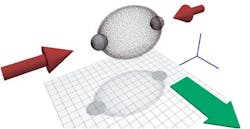Laser light "dresses" ultracold atoms in BEC, revealing new types of scattering
Gaithersburg, MD and Mexico City, Mexico--Scientists at the National Institute of Standards and Technology (NIST) and the Centro de Investigación y Estudios Avanzados del Instituto Politécnico Nacional have figured out how to "dress" ultracold atoms with laser light (meaning the light mixes together different quantum energy states within the atoms); such atoms can be used as proxies to study phenomena that would be difficult or impossible to study in other contexts. Their most recent work demonstrates a new class of interactions thought to be important to the physics of superconductors that could be used for quantum computation.1
“Basically, we’re able to simulate these complicated systems and observe how they work in slow motion,” says Ian Spielman, a physicist at NIST and fellow of the Joint Quantum Institute (JQI), a collaborative enterprise of NIST and the University of Maryland.
According to Ross Williams, a postdoctoral researcher at NIST, cold atom experiments are good for studying many-body systems because they offer a high degree of control over position and behavior of the atoms.
First, the researchers trap rubidium-87 atoms using magnetic fields and cool them down to 100 nK, says Williams. At these temperatures, they become a Bose-Einstein condensate (BEC). Once they have dressed the atoms, we split the condensate, collide the two parts, and then see how they interact.
According to Williams, without being laser-dressed, simple, low-energy interactions dominate how the atoms scatter as they come together. While in this state, the atoms scatter in a spherically symmetric way, providing no information. When dressed, however, the atoms tended to scatter in directional ways indicative of the influence of novel interactions not normally seen in ultracold atom systems.
While the researchers used rubidium atoms, which are bosons, for this experiment, they are modifying the scheme to study ultracold fermions. The group hopes to find evidence of the Majorana fermion—an enigmatic, still theoretical kind of particle that is involved in superconducting systems important to quantum computation.
“A lot of people are looking for the Majorana fermion,” says Williams. “It would be great if our approach helped us to be the first.”
For more info, see “The Impact of Quantum Matter” at http://jqi.umd.edu/news/291-the-impact-of-quantum-matter.html
REFERENCE:
1. R.A. Williams et al., Science Express, 8 December 2011.

John Wallace | Senior Technical Editor (1998-2022)
John Wallace was with Laser Focus World for nearly 25 years, retiring in late June 2022. He obtained a bachelor's degree in mechanical engineering and physics at Rutgers University and a master's in optical engineering at the University of Rochester. Before becoming an editor, John worked as an engineer at RCA, Exxon, Eastman Kodak, and GCA Corporation.
